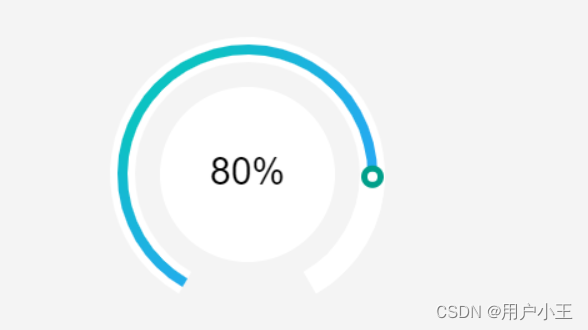前言
开始时用vue实现了一个圆弧滑动条,因为uniapp自己封装了canvas方法,移植到uniapp时并不能适用。于是进行了修改。
实现
<canvas style="height: 300px; width: 300px;" ref="myCanvas" canvas-id="myCanvas" @touchstart="canvasDown" @touchmove="canvasMove" @touchend="canvasUp"></canvas>
<script>
import {
hideTabBar
} from "@/common/util.js"
import slideableImg from "@/static/settings/slideable.png"
export default {
data() {
return {
pageUrl: {
info: 'device/loadDevice', // 设备信息
edit: 'appDevice/singleSetting' // 保存设备信息
},
// 画布
canvas: '',
// 画笔
ctx: '',
// 是否可以拖动
canvasMoveUse: false,
// 可滑动提醒图片
slideableImg,
// 显示的电量百分比
showCharge: 50,
// 设备信息
deviceInfo: {},
// 设备id
deviceId: '',
// 用户id
userId: ''
}
},
created() {
hideTabBar()
},
computed: {
// 显示百分比
showChargePercent(){
return this.showCharge + '%'
}
},
onLoad() {
this.deviceId = uni.getStorageSync('deviceId')
this.userId = uni.getStorageSync('consumer').id
this.$nextTick(() => {
this.initCanvas()
})
},
onShow() {
uni.setNavigationBarTitle({
title: this.$t('function.deviceDischarge')
});
// 获取设备信息
// this.getDischargeInfo()
},
// 监听返回事件
onBackPress() {
},
methods: {
// 初始化
async initCanvas() {
await this.getDischargeInfo()
let realAngel = (0.01 * (Math.PI * 5 / 3) * this.showCharge) + ((Math.PI * 2) / 3)
let x = this.getInitX(150, 150, 100, this.showCharge)
let y = this.getInitY(150, 150, 100, this.showCharge)
this.ctx = uni.createCanvasContext("myCanvas")
this.drawDefaultRing()
// this.drawRingByTouch(Math.PI * 9 / 6)
this.drawRingByTouch(realAngel)
this.drawPoint(x, y)
this.drawText(this.showChargePercent)
this.ctx.draw()
},
// 画默认的圆弧
drawDefaultRing() {
this.ctx.beginPath()
this.ctx.setLineWidth(20)
this.ctx.setStrokeStyle('#fff')
this.ctx.arc(
150, 150,
100,
0, Math.PI * 2 / 6,
false
);
this.ctx.stroke();
this.ctx.beginPath()
this.ctx.arc(
150, 150,
100,
Math.PI * 4 / 6, Math.PI * 14 / 6,
false
);
this.ctx.stroke();
},
// 画圆点
drawPoint(x, y) {
this.ctx.beginPath()
this.ctx.setFillStyle('#009f8a')
this.ctx.arc(
x, y,
9,
0, Math.PI * 2
)
this.ctx.fill();
this.ctx.beginPath()
this.ctx.setFillStyle('#ffffff')
this.ctx.arc(
x, y,
4,
0, Math.PI * 2
)
this.ctx.fill();
},
// 画圆弧
drawRingByTouch(angle) {
this.ctx.beginPath()
this.ctx.setLineWidth(8)
var gr = this.ctx.createLinearGradient(80, 150, 220, 150);
//添加颜色端点
gr.addColorStop(0, 'rgba(12, 194, 194, 1)');
gr.addColorStop(.24, 'rgba(46, 163, 255, 1)');
gr.addColorStop(.58, 'rgba(74, 115, 247, 1)');
gr.addColorStop(.78, 'rgba(74, 115, 247, 1)');
gr.addColorStop(1, 'rgba(139, 71, 222, 1)');
//应用fillStyle生成渐变
this.ctx.setStrokeStyle(gr);
this.ctx.arc(
150, 150,
100,
(Math.PI * 4 / 6), angle,
false
);
this.ctx.stroke();
},
// 写文字
drawText(text) {
// 文字下方底色
this.ctx.beginPath()
this.ctx.setFillStyle('#ffffff')
this.ctx.arc(
150, 150,
70,
0, Math.PI * 2
)
this.ctx.fill();
this.ctx.beginPath()
// text = '75%';
//字体颜色
this.ctx.font = '30px arial';
this.ctx.fillStyle = '#000000';
// 位置
this.ctx.textAlign = 'center';
this.ctx.textBaseline = 'middle';
//描边宽度
this.ctx.lineWidth = 3;
//填充文字
this.ctx.fillText(text, 150, 150);
},
canvasDown(e) {
this.canvasMoveUse = true;
},
canvasMove(e) {
if (this.canvasMoveUse) {
let canvasX = e.touches[0].x
let canvasY = e.touches[0].y
// console.log(canvasX + ',' + canvasY);
let angle = Math.atan((canvasY - 150) / (canvasX - 150))
let x = this.getX(150, 150, 100, canvasX, canvasY)
let y = this.getY(150, 150, 100, canvasX, canvasY)
let realAngle = this.getRealAngle(canvasX, canvasY, angle)
// 半圆的滑动范围判断
if (realAngle <= (Math.PI * 14 / 6) && realAngle >= (Math.PI * 9 / 6)) {
let percent = ((realAngle - (2 * Math.PI / 3)) / (Math.PI * 5 / 3)).toFixed(2)
let showPercent = (percent * 100).toFixed(0)
this.showCharge = showPercent
// console.log(realAngle);
this.$nextTick(() => {
this.ctx.clearRect(0, 0, 300, 300)
this.drawDefaultRing()
this.drawRingByTouch(realAngle)
this.drawPoint(x, y)
this.drawText(this.showChargePercent)
this.ctx.draw()
})
}
}
},
/**
* 获取角度
* @param canvasX 鼠标x坐标
* @param canvasY 鼠标y坐标
* @param angle 根据反正切函数算出的角度
*/
getRealAngle(canvasX, canvasY, angle) {
let realAngle = 0
if (canvasX < 150 && canvasY > 150) {
realAngle = (Math.PI / 2) - Math.abs(angle) + Math.PI / 2
}
if (canvasX < 150 && canvasY < 150) {
realAngle = Math.abs(angle) + (Math.PI / 2) + Math.PI / 2
}
if (canvasX > 150 && canvasY < 150) {
realAngle = (Math.PI / 2) - Math.abs(angle) + Math.PI + Math.PI / 2
}
if (canvasX > 150 && canvasY > 150) {
realAngle = Math.abs(angle) + Math.PI * (3 / 2) + Math.PI / 2
}
return realAngle
},
/**
* 获取在圆上x轴坐标
* @param ox 原点x坐标
* @param oy 原点y坐标
* @param r 圆的半径
* @param x 鼠标x轴坐标
* @param y 鼠标y轴坐标
*/
getX(ox, oy, r, x, y) {
// 角度
let angle = Math.atan((oy - y) / (x - ox))
// x轴长度
let realX = Math.abs(r * Math.cos(angle))
if (x < ox) {
return (-realX) + ox
} else {
return realX + ox
}
},
/**
* 根据初始值获取初始的x
* @param ox 原点x坐标
* @param oy 原点y坐标
* @param r 半径
* @param angle
*/
getInitX(ox, oy, r, angle) {
let tempAngle = (angle * (Math.PI * 5 / 3 * 0.01) + Math.PI / 6)
if (tempAngle <= Math.PI) {
return (-Math.abs(r * Math.sin(tempAngle))) + ox
} else if (tempAngle > Math.PI) {
return Math.abs(r * Math.sin(tempAngle)) + ox
}
},
/**
* 根据初始值获取初始y
* @param ox 原点x坐标
* @param oy 原点y坐标
* @param {Object} r 半径
* @param {Object} angle 角度
*/
getInitY(ox, oy, r, angle) {
let tempAngle = (angle * (Math.PI * 5 / 3) * 0.01 + Math.PI / 6)
if ((tempAngle <= Math.PI / 2) || (tempAngle >= Math.PI * 3 / 2)) {
return oy + Math.abs(r * Math.cos(tempAngle))
} else if ((tempAngle > Math.PI / 2) && (tempAngle < Math.PI * 3 / 2)) {
return oy - Math.abs(r * Math.cos(tempAngle))
}
},
/**
* 获取在圆上y轴坐标
* @param ox 原点x坐标
* @param oy 原点y坐标
* @param r 圆的半径
* @param x 鼠标x轴坐标
* @param y 鼠标y轴坐标
*/
getY(ox, oy, r, x, y) {
// 角度
let angle = Math.atan((oy - y) / (x - ox))
// y轴长度
let realY = Math.abs(r * Math.sin(angle))
if (y < oy) {
return (-realY + oy)
} else {
return realY + oy
}
},
canvasUp(e) {
this.canvasMoveUse = false
},
canvasLeave(e) {
this.canvasMoveUse = false
},
/**
* 获取设备放电信息
*/
getDischargeInfo() {
let params = {
id: this.deviceId
}
return this.$http('GET', this.pageUrl.info, params)
.then(res => {
if (res.success) {
if(this.showCharge){
this.deviceInfo = res.result // 保存设备信息
this.showCharge = Number(res.result.battery_low_discharge)
}
} else {
this.$showToast(res.message)
}
})
.catch(err => {
this.$showToast(err.message)
})
},
// 保存
save() {
let params = {
id: this.deviceId,
battery_low_discharge: Number(this.showCharge) ,
user_id: this.userId
}
this.$http('POST', this.pageUrl.edit, params)
.then(res => {
if(res.success){
this.$showToast(res.message)
}else{
this.$showToast(res.message)
}
})
.catch(err => {
this.$showToast(err.message)
})
}
}
}
</script>
效果:





















 1017
1017











 被折叠的 条评论
为什么被折叠?
被折叠的 条评论
为什么被折叠?








